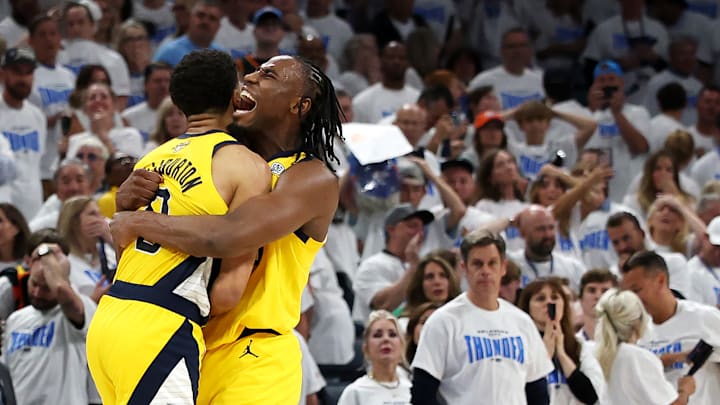Aaron Nesmith credits regular season hurdles with preparing Pacers for postseason heroics.
The Indiana Pacers are rewriting the narrative on how significant a late-game deficit truly is. Fueled by the otherworldly clutch heroics of All-NBA point guard Tyrese Haliburton, Indiana has made a habit out of erasing margins that should've been safely protected.
The question that so many have posed in response to this generational display of late-game success has been as simple as it is complex: How are they doing this?
The question has only grown louder as Indiana celebrates its most significant turnaround to date. It trailed for all but 0.3 seconds during Game 1 of the 2025 NBA Finals, yet somehow managed to come away with a road win over the dominant 68-win Oklahoma City Thunder.
According to Marc J. Spears of Andscape, Pacers sharpshooter Aaron Nesmith explained the experience and mentality that has enabled the team to overcome almost any deficit it faces.
“I’d say the [comeback] belief came in the regular season,” Pacers guard Aaron Nesmith told Andscape. “We finished the regular season with a lot of close games and a lot of games we were down and put ourselves in bad position. Honestly, we just looked at it as practice – practice to prepare for these moments.”
No hyperbole is necessary when stating that Indiana has made itself at home when facing a deficit that should otherwise destroy their momentum.
Aaron Nesmith attributes comeback mentality to regular season experiences
40 of the Pacers' regular season games were decided by nine points or less, during which time it amassed a record of 25-15. It also played eight games that were decided by no more than three points, compiling a 6-2 record along the way.
Furthermore, Indiana went to overtime on six occasions during the regular season—more than all but two teams. It went 5-1 in those outings.
The Pacers were also one of just seven teams to compile an above-.500 record against teams that finished at 41-41 or better. That poise under pressure, no matter the quality of the opposition, seemingly prepared it for what it's encountered in the playoffs.
For as fair of an explanation as that may be, one still can't help but feel as though there's no real way to determine the source of such a magical run.
Pacers trailed by 9 with 2:52 to play. In play by play era (since start of 1997 playoffs), teams were 0-121 in NBA Finals when trailing by 7+ points in final 3:00 of 4th quarter or OT before tonight
— Josh Dubow (@JoshDubowAP) June 6, 2025
In Game 5 of Indiana's first-round series against the Milwaukee Bucks, the Pacers trailed by 20 points in the first quarter. They erased that deficit, only to end up down 118-111 with 40.1 seconds remaining in overtime.
In that span of 40.1 seconds, the Pacers went on an 8-0 run and somehow closed the series out with a 119-118 victory that had to be seen to be believed.
Two outings later, the Pacers came back from an 81-61 deficit with 6:51 remaining in the third quarter of Game 2 against the 64-win Cleveland Cavaliers. To make matters even more dire, they trailed by 17 points with just six seconds remaining in the third.
Even still, they won 120-119—and then went on to erase a 19-point deficit to send the Cavaliers packing in Game 5 of the same series.
In Game 1 of the Eastern Conference Finals, Indiana came back from trailing 111-94 with 6:26 remaining in the fourth quarter to defeat the New York Knicks 138-105 in overtime. They were behind by 14 points with just 3:44 remaining and trailed by nine points with just 51.1 seconds on the clock.
Nesmith can attribute the Pacers' comebacks to regular-season events all he wants, but sometimes, magic can't be explained by human experience.
